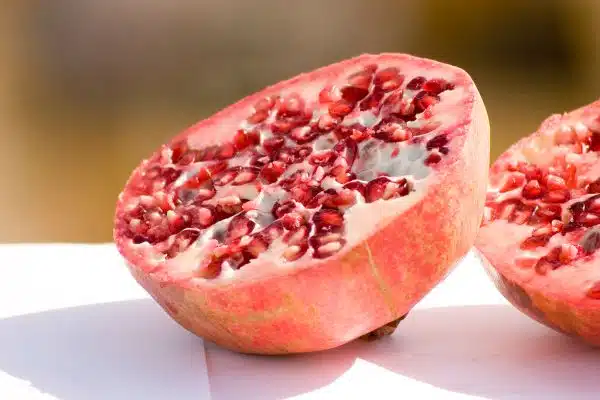Growing pomegranates indoors can be a rewarding experience that allows us to enjoy the benefits of this delicious fruit all year round. Pomegranate trees are native to various regions of the world and have been cultivated for centuries as both an ornamental and edible plant. In recent years, growing pomegranates indoors has gained popularity due to their hardiness, adaptability, and potential health benefits.
Pomegranate trees require specific care and attention to thrive indoors. Understanding the proper growing conditions, pruning techniques, and pest control methods is key for successful cultivation. In this article, we will explore the steps required to grow healthy and robust pomegranate trees in indoor settings. Whether you are looking to add some greenery to your home or simply love the taste of fresh pomegranates, this guide will provide you with valuable insights into how to grow these fruits successfully.
Choosing The Right Variety Of Pomegranate Tree
Ah, the elusive pomegranate tree. A symbol of prosperity, abundance and good luck in many cultures around the world. But can it really be grown indoors? The answer is yes, with a bit of patience and careful planning. Before we get into the nitty-gritty of pomegranate tree maintenance, let’s first talk about selecting the right variety for indoor cultivation.
When it comes to choosing the best indoor pomegranate varieties, there are a few things to consider. Firstly, you’ll want to look for a self-pollinating variety if you don’t plan on having another pomegranate tree nearby. Some popular options include ‘Wonderful’, ‘Eversweet’ and ‘Ambrosia’. Secondly, consider the size of your space. If you have limited room, opt for a dwarf or semi-dwarf variety such as ‘Nana’ or ‘Angel Red’. Finally, take note of the climate in your area – some varieties may not do well in certain conditions.
Once you’ve selected your ideal pomegranate variety for indoor growth, it’s important to keep up with regular maintenance. This includes proper watering (not too much or too little), fertilization during growing season and pruning as needed to promote healthy growth. With these considerations in mind, let’s move onto selecting the right container for optimal indoor cultivation.
Selecting The Right Container For Indoor Cultivation
When it comes to selecting a container for indoor pomegranate cultivation, there are a few key factors to consider. First and foremost, choose a container that is large enough to accommodate the root system of your tree. Pomegranate trees have an extensive root system and require ample space for growth. Additionally, make sure the container has adequate drainage holes to prevent water from accumulating in the bottom of the pot.
There are several materials to choose from when selecting a container for your pomegranate tree. Terracotta pots are popular among gardeners due to their porous nature, which allows air and moisture to circulate around the roots. Plastic containers are also a viable option as they are lightweight and less prone to breakage than terracotta pots. Ultimately, the choice of material will depend on personal preference and availability.
Drainage solutions are crucial for healthy indoor pomegranate cultivation. When water accumulates at the bottom of the pot, it can lead to root rot or other fungal diseases that can harm your plant’s health. To prevent this from happening, consider using a layer of gravel or perlite at the bottom of your container before adding soil. This will create a barrier between your plant’s roots and any excess water, allowing for proper drainage and preventing waterlogging.
As you begin to plan out your indoor pomegranate cultivation project, be sure to carefully consider the type of container you select and how you plan on providing adequate drainage for your plant’s health. In the next section, we will discuss how to provide sufficient lighting for optimal growth and fruit production in your pomegranate tree.
Providing Adequate Lighting For Your Pomegranate Tree
Selecting the right container is just one part of successfully growing pomegranates indoors. In addition to the container, providing adequate lighting is also crucial for the tree’s growth and development. While pomegranate trees thrive in full sunlight outdoors, indoor cultivation requires a bit more attention to lighting.
One option for indoor pomegranate tree lighting is LED lights. These can be purchased specifically for plant growth and emit wavelengths that promote photosynthesis. However, it’s important to note that not all LED lights are created equal, so it’s important to do research on which ones will work best for your specific tree.
Another option is utilizing natural light sources, such as placing the tree near a south-facing window or using reflective surfaces to bounce light around the room. Keep in mind that pomegranate trees require at least six hours of direct sunlight per day, so if natural light sources aren’t providing enough light, supplemental LED lighting may be necessary. By providing adequate lighting for your indoor pomegranate tree, you’ll help ensure its success and overall health.
As important as selecting the right container and providing adequate lighting is controlling temperature and humidity levels. Indoor environments often lack the natural fluctuations of outdoor environments, so it’s essential to create an environment that mimics outdoor conditions as closely as possible. In the next section, we’ll discuss how to properly control temperature and humidity levels for your indoor pomegranate tree to ensure optimal growth and yield.
Temperature And Humidity Control For Indoor Pomegranate Trees
As the saying goes, “you can’t control the weather,” but when it comes to growing pomegranates indoors, controlling temperature and humidity is essential. Pomegranate trees thrive in areas with a Mediterranean climate, meaning they prefer warm days and cool nights. However, indoor environments can be challenging to mimic these conditions. Therefore, it’s crucial to manage the temperature and humidity levels for successful indoor pomegranate growth.
Humidity control is essential when growing pomegranates indoors. These trees prefer a moderate level of humidity between 40% to 70%. Maintaining proper humidity levels prevents issues such as leaf drop and fruit splitting. One way to increase humidity is by placing a tray of water near the plant or using a humidifier. Conversely, if the air is too humid, it can lead to fungal growth or pest infestations; hence monitoring the levels regularly is necessary.
Temperature management also plays a significant role in indoor pomegranate growth. During the daytime, temperatures between 60°F to 80°F are ideal for their growth. At night, temperatures between 40°F to 60°F are preferable for promoting healthy fruit development. Investing in thermostats and heaters will help regulate temperatures during cold weather months while opening windows or using fans will help with ventilation during warmer months.
To ensure that your indoor pomegranate tree thrives, maintain proper temperature and humidity levels throughout its life cycle. Remember that every cultivar has unique needs; therefore, always research specific requirements for your particular variety before making any adjustments. In the next section, we’ll discuss soil and fertilizer requirements for successful growth- an equally crucial aspect of indoor pomegranate cultivation.
Soil And Fertilizer Requirements For Successful Growth
To ensure successful growth of pomegranates indoors, it is crucial to use soilless mixes that are rich in nutrients. These mixes offer better drainage and provide the right balance of air and water for the roots. Organic fertilizers such as compost, worm castings, and fish emulsion can be added to these mixes to provide essential nutrients for the plants.
It is important to maintain a balanced pH level in the soilless mix as this affects the plant’s ability to absorb nutrients. The ideal pH range for pomegranate trees is between 5.5 and 7.0. To achieve this, lime or sulfur can be added depending on whether the soil needs to be more alkaline or acidic respectively.
Using organic fertilizers and a well-balanced soilless mix can help nourish your indoor pomegranate trees and promote healthy growth. However, it is equally important to manage the pH levels in your soil, ensuring that your plants can absorb all necessary nutrients efficiently. By following these guidelines, you will set yourself up for success in growing healthy pomegranates indoors.
To continue caring for your indoor pomegranate tree successfully, proper watering techniques and frequency are crucial.
Watering Techniques And Frequency For Pomegranate Trees
To ensure successful growth of pomegranate trees, proper watering techniques and frequency are crucial. Overwatering or underwatering can both lead to detrimental effects on the tree’s growth and fruit production. The best way to water pomegranate trees is through drip irrigation, which allows for slow and controlled delivery of water directly to the roots.
It is important to monitor soil moisture regularly, as pomegranate trees require moist but well-draining soil. A simple way to check soil moisture levels is by inserting a finger into the soil up to the second knuckle. If the soil feels dry, it is time to water the tree. However, if the soil feels wet or overly saturated, it is best to hold off on watering until it dries out a bit.
Proper watering techniques combined with regular monitoring of soil moisture will help promote healthy growth and fruit production in your indoor pomegranate tree. In addition to these practices, pruning and training your pomegranate tree is also essential for its success.
Pruning And Training Your Pomegranate Tree
To ensure that your indoor pomegranate tree thrives, pruning and training are essential practices. Pruning techniques involve selectively removing branches to enhance the tree’s structural integrity and encourage fruit production. Training methods aim to shape the tree into a desirable form while optimizing sunlight exposure.
- Before beginning any pruning or training, sterilize your tools with rubbing alcohol to prevent disease transmission.
- Begin by removing any dead, damaged, or diseased wood. Then, prune any crossing branches that rub against each other or grow toward the center of the tree.
- To train your pomegranate tree into a particular shape, select a central leader branch and remove any competing leaders. Trim back side branches by about one-third of their length annually.
By learning proper pruning and training techniques, you can help your indoor pomegranate tree reach its full potential. Not only will it produce more fruit, but it will also maintain an attractive form that is easy to manage. In the next section, we will discuss preventing and managing pests and diseases to further protect your investment in this beautiful plant.
Preventing And Managing Pests And Diseases
- Preventing pests requires using proper cultural practices including proper soil preparation, proper spacing, and proper pruning.
- Managing pests involves the use of horticultural oils and insecticides to reduce their numbers and limit damage to the pomegranate plants.
- Preventing diseases involves proper sanitation and removal of infected parts as well as using resistant cultivars.
- Managing diseases requires the use of fungicides to stop the spread of disease and help the plants to recover.
Preventing Pests
Pomegranates are a delicious and healthy fruit that can be grown indoors. However, like any other plant, they are susceptible to pests and diseases. Pest infestations can lead to stunted growth, reduced yields, and even death of the plant. It is important to take preventive measures to keep your pomegranate plants healthy and pest-free.
One natural pest control method is to introduce beneficial insects into your indoor garden. Ladybugs, lacewings, and praying mantises are all effective in controlling pests such as aphids, spider mites, and whiteflies. You can also make homemade pest repellents using ingredients such as garlic, chili peppers, and essential oils. These repellents work by creating an unpleasant environment for pests without harming the plants.
Regular monitoring of your pomegranate plants is also important in preventing pest infestations. Check for any signs of damage or discoloration on leaves or fruits. If you notice any pests, remove them by hand or use a gentle spray of water to dislodge them from the plant. By taking these preventive measures and using natural pest control methods, you can ensure that your indoor pomegranate plants remain healthy and productive for years to come.
Managing Pests
Preventing and managing pests and diseases in indoor pomegranate plants is crucial to achieving a bountiful harvest. Pests such as aphids, spider mites, and whiteflies can cause significant damage to the plant, leading to stunted growth, decreased yield, and even death. Diseases such as fungal infections can also affect the fruit’s quality and quantity.
Organic pest control methods are recommended for indoor pomegranate plants. Using natural remedies such as beneficial insects or homemade pest repellents is an effective way to keep pests at bay without harming the plant. Introducing ladybugs, lacewings, or praying mantises into your garden helps control pests like aphids, spider mites, and whiteflies naturally. Homemade pest repellents made from garlic, chili peppers, or essential oils create an unpleasant environment for pests without harming the plant.
Regular monitoring of your indoor pomegranate plants is also important in preventing pest infestations. Check for any signs of damage or discoloration on leaves or fruits regularly. If you notice any pests, remove them by hand or use a gentle spray of water to dislodge them from the plant. By taking these preventive measures and using natural pest control methods like organic pest control and natural remedies, you can ensure that your indoor pomegranate plants remain healthy and productive for years to come.
Harvesting And Storing Your Pomegranate Fruit
Pomegranates are ready for harvest when the skin has turned a deep red color, and the fruit feels heavy. To ensure that you get the freshest fruit, it is best to pick them from your indoor tree as soon as they are ripe. You should gently twist each fruit off the branch, taking care not to damage the stem or surrounding branches. Once harvested, store your pomegranates in a cool, dry place such as a pantry or refrigerator.
Pomegranate recipes are plentiful, and this versatile fruit can be used in sweet or savory dishes. The seeds can be eaten fresh or juiced for use in drinks or smoothies. Pomegranate juice is also used in cocktails and adds a unique flavor to marinades and dressings. In addition to its culinary uses, pomegranates offer many health benefits such as being high in antioxidants which help protect against cancer and heart disease.
After harvesting your pomegranates and trying out some delicious recipes, it’s important to troubleshoot any common issues you may encounter in indoor pomegranate cultivation. Some common problems include yellowing leaves due to overwatering or underwatering, pests such as spider mites or mealybugs, or lack of fruit production due to insufficient light or nutrients. By addressing these issues promptly, you can ensure that your indoor pomegranate tree continues to thrive and provide you with fresh fruit for years to come.
Troubleshooting Common Issues In Indoor Pomegranate Cultivation
One of the biggest challenges faced by indoor pomegranate growers is dealing with common issues that may arise during cultivation. While growing pomegranates indoors has its benefits, including protection from pests and diseases, the lack of natural conditions can create difficulties in maintaining optimal growth. However, with a few simple steps, it’s possible to troubleshoot these issues and ensure healthy plant development.
Dealing with pests is one of the most common problems faced by indoor pomegranate growers. Pests like spider mites, aphids, and whiteflies can infest plants and cause significant damage to leaves and fruits. To prevent this issue, it’s important to regularly inspect your plants for signs of pest activity. If you notice any pests, you can use natural insecticidal sprays or soapy water solutions to remove them from your plants.
Nutrient deficiencies are another issue that may arise during indoor pomegranate cultivation. These deficiencies can manifest as yellowing leaves, stunted growth or poor fruit development. As such, it’s important to monitor your plant’s nutrient intake through careful fertilization practices. Ensure that you provide your pomegranate trees with adequate amounts of nitrogen, phosphorus and potassium through slow-release fertilizer applications every 6-8 weeks.
In summary, indoor pomegranate cultivation requires careful attention to detail in order to maximize plant health and productivity. By preventing pest infestations through regular inspection and using natural insecticidal sprays when necessary, as well as monitoring nutrient levels through proper fertilization practices, you can ensure that your plants thrive in an indoor environment. With patience and diligence on the part of the grower, successful indoor pomegranate cultivation is achievable!
Conclusion
Growing pomegranates indoors can be a rewarding experience for any gardener. With the right variety of tree, container, lighting, temperature and humidity control, soil and fertilizer, pruning and pest management techniques, you can successfully grow your own juicy and nutritious pomegranate fruit.
When selecting the right variety of pomegranate tree for indoor cultivation, consider dwarf or compact varieties that are suitable for container growth. The container should be large enough to allow the tree to grow freely while providing adequate drainage. Proper lighting is crucial for photosynthesis and fruit development, so choose a sunny location or use artificial lighting if necessary.
Maintaining consistent temperature and humidity levels is important for healthy growth. Use a well-draining potting mix with regular fertilization to provide essential nutrients. Pruning helps control growth and shape the tree while preventing disease. Regular monitoring of pests and diseases will help prevent infestation.
In conclusion, growing pomegranates indoors can be challenging yet rewarding with proper care and attention. You can enjoy your own homegrown pomegranate fruit with these helpful tips. So why not give it a try? With patience, persistence and a little bit of green thumb magic, you too can become an expert in indoor pomegranate cultivation!
Image Credits
- “Pomegranate” by shyb (featured)





























